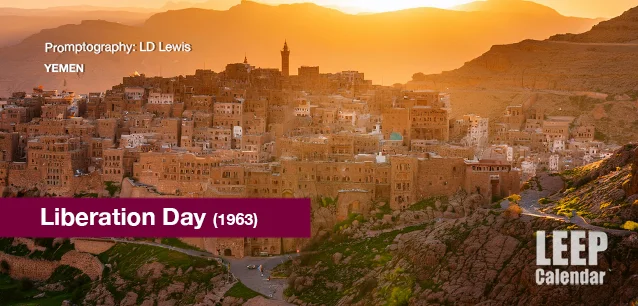 AD
AD
Today is: December 25
Scroll to explore events active on this date.
Additional Events on LEEP
LEEP INK FEATURES

August? Absolutely!
In August, we live through the Dog Days of Summer. It's hot and often humid, and those who can leave for better climates do. Down south, winter is in full force. August is also known as "the ...

In The Heat of July: July 2025 Events
Is it hot enough (or cold enough if you're below the equator) for you yet? There is actually a day for that! Like every month, I pick a diverse collection of events you may or may not know about. This ...

May Blooms: Events in May 2025
Along with October, May is one of the most densely packed months of the year. It's before the summer humidity and the last whole month of the school year. The weather is warming in t...
About Liberation Day in Yemen
Military , Civil Rights
Middle East/West Asia
Ends: Oct 14, 2024
DESCRIPTION:
ENDING BRITISH COLONIAL RULE:
LIBERATION DAY IN YEMEN
The October 14, 1963, revolution in Yemen marks a significant turning point in the country's history. It began the armed struggle against British colonial rule in southern Yemen, particularly in the region known as the Aden Protectorate.
The revolution was ignited in response to growing discontent among Yemenis, who were frustrated with the harsh conditions under British rule and inspired by the broader wave of anti-colonial movements sweeping across the Arab world. The struggle for independence in southern Yemen received further inspiration from the concurrent North Yemeni revolution of 1962, which overthrew the monarchy and established the Yemen Arab Republic.
On October 14, 1963, an armed revolt was launched in the mountainous region of Radfan, led by a group of nationalist fighters. This event is regarded as the official start of the South Yemeni revolution. The uprising quickly spread across the region, with various nationalist groups, including the National Liberation Front (NLF) and the Front for the Liberation of Occupied South Yemen (FLOSY), leading the charge against British forces.
The revolution deployed guerrilla warfare, with Yemeni fighters employing hit-and-run tactics against the better-equipped British military. Despite the odds, the revolutionaries gained significant ground, drawing on widespread popular support from the Yemeni population.
The struggle culminated in the withdrawal of British forces from Aden on November 30, 1967, and the establishment of the People's Republic of South Yemen, which later became the People's Democratic Republic of Yemen. This victory ended over a century of British colonial presence in the region and began a new chapter in Yemeni history.
The October 14 revolution is commemorated annually in Yemen as Liberation Day, a symbol of national pride and resistance against foreign domination. The event is celebrated with ceremonies, parades, and cultural activities that honor the sacrifices made by those who fought for Yemen's independence.
HISTORY OF YEMEN
Yemen's history is as complex as it is ancient. Situated at the southern tip of the Arabian Peninsula, Yemen has been a crossroads of civilizations for thousands of years. The country's strategic location made it a vital center for trade, particularly in the ancient incense trade routes that connected the East and West. Yemen's oldest city, Shibam, often called the "Manhattan of the Desert" due to its impressive mudbrick skyscrapers, dates back to the second century CE and is a UNESCO World Heritage site.
Over the centuries, Yemen has seen various kingdoms and empires rise and fall. The ancient Kingdom of Saba, often associated with the legendary Queen of Sheba, was one of the most powerful in the region, known for its wealth and trade networks. Following the decline of these ancient kingdoms, Yemen became part of various Islamic caliphates and later the Ottoman Empire.
In the 19th century, Yemen's strategic location attracted the attention of European powers, leading to the British occupation of Aden in 1839. The southern part of Yemen remained under British control until 1963 when a prolonged struggle for independence culminated in the withdrawal of British forces and the establishment of the People's Democratic Republic of Yemen (South Yemen). This event is today's celebration.
YEMENI CULTURE
Yemen evolved into two separate states: the Yemen Arab Republic (North Yemen) and the People's Democratic Republic of Yemen (South Yemen). In 1990, the two states combined, forming the Republic of Yemen, although the country has since faced significant internal conflicts and challenges.
Yemen is famous for its rich cultural heritage, which includes traditional architecture, poetry, and music. The country is also known for its coffee production, particularly the Mocha variety, named after the Yemeni port city that was once a major coffee trading hub. Additionally, Yemen is renowned for its historical sites, such as the ancient city of Sana'a, with its unique multi-story buildings adorned with intricate geometric patterns.
Liberation Day reminds us of Yemen's long history of resilience and ongoing struggle for peace and stability. As the country navigates its complex political landscape, celebrating this day symbolizes the enduring spirit of the Yemeni people and their commitment to their nation's future.
VIDEOS
SUPPORTING DOCUMENTS
Currently, this event does not have supporting documents.
ADDITIONAL IMAGES
Currently, this event does not have supporting images.
Where would you like to go now?
 AD
AD


/footer-logo.svg)
